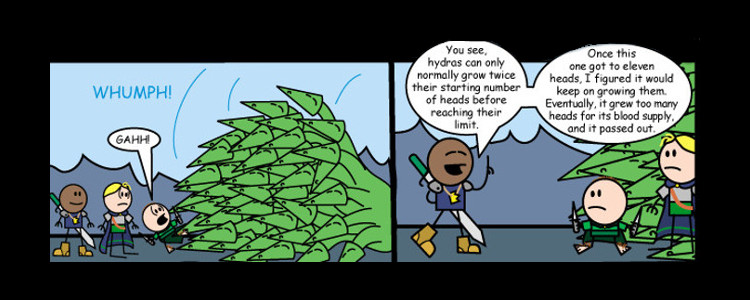I recently saw Ready Player One, which I enjoyed despite a small but significant choice made early on by director Steven Spielberg (no idea if the issue starts in the book). This is not a spoiler for plot but it may spoil your viewing experience. If you want to go in fresh, skip the following paragraph.
Parts of the movie take place inside a shared virtual reality. The first time we see someone log out of this world, she does so by removing her VR helmet. Shortly thereafter, there is a scene where our heroes are ambushed and outnumbered. They scramble to run away because if your avatar gets killed, there are in-game consequences. And as viewers, my wife and I both vocalized in the theatre “just take off your helmets!” Many (most, even) future action scenes could have been resolved by taking their helmet off. This is both a credit to the film for getting us so engaged that we learned through character actions how the world works and the film discrediting itself by not understanding how its own world works.
This illustrates the importance of internal consistency in a story, especially when dramatic tension and immersion hinge on a problem that has been demonstrated to have a simple solution. Every story sets up and follows rules, even if they aren’t as transparent as an in RPG. In a Fast And The Furious movie, The Rock make his cast explode by flexing and then go on a mission like there’s nothing wrong with it because in that world doctors don’t understand that the real cure for broken bones is gumption. Transplant that scene to The Avengers and it ruins the movie.
This isn’t about the Pathfinder rules system exclusively. You can play by all of the rules as written and still have consistency issues, and you can play fast and loose with the rules without consistency issues. Here are a few examples to flesh out how.
One True Ruler
The most basic example of consistency is the application of the rules. My players know that I am a stickler for handle animal skill checks to get animal companions to obey them. The common arguments against this are: It’s not realistic, an animal would defend itself (which is false. The first step of training an animal is called breaking it, and it’s convincing the animal to trust its master more than its instincts); It’s inconvenient (which it isn’t once you get used to it); It’s a lot of die rolls (which is true, but I will never understand anyone’s desire to not roll dice. I’ll get into this in a future article). My reasoning is provided for the benefit of the reason. What’s important at my table is that my players know I enforce this rule and build their characters accordingly. What I’m not a stickler for is the fly rules. Then one day I played a PFS scenario with a GM who was a stickler for fly rules. The next session of my Rise of the Runelords campaign, Jeff’s wizard flew. I casually remarked “Oh, yeah, you’re supposed to make a fly check.” But Jeff didn’t have any ranks in fly. Even if he did, it is so well known that Jeff rolls poorly, our group called rolling a 1 “Jeffing” and we all got novelty dice with Jeff in place of the 1.

Pictured: Jeff
Jeff had built a character that required minimal rolling. Because I never enforced needing to roll to fly, he built his character accordingly. Even if that is the rule, my choosing to suddenly enforce the rule was unfair to him. In retrospect, I should have announced my intention and either let him rebuild his character to meet my new expectations or wait until he gained a level to enforce them.
Dramatic Pause
I used to be fine putting story before mechanics. One memorable occasion, I had a villain flee the room. The party monk pursued, only to find him across an underwater river cutting the bridge between them.
“How?” the monk player asked. He compared the two character’s speeds and starting points, and the number of actions it would require to do everything I said this NPC did off-screen. And he was 100% right. I was denying this player access to his one of his class features because I wanted a villain to escape. I retroactively placed the NPC where the rules said he could be and left the monk with super human speed catch him, as he should have.
From then on I paid more mind to the rules implications of story tropes. I lost a few old standbys (an NPC can’t give a desperate plea with his dying breath because he’s either unconscious and dying or conscious and stable), but I gained the true storytelling potential of tabletop RPGs. Dramatic tension occurs organically through who the characters are and what they can do instead of inorganically at the expense of it.
Accounting For Magic
Picture a castle.
The typical castle is a tall, stone building contained inside a stone wall with an open courtyard. Why is the court open? Because the tall wall covered virtually all of its defensive needs at that point in technological advancement. In a world where any dragon, moderately trained wizard, and many other threats can circumvent a castle’s expensive defenses, those worried about their safety wouldn’t stop at a wall. Even if the setting retained a mostly medieval level of technology, necessity is the mother of invention. Rich landowners concerned about safety would find a way to stave off flying attacks. On the flipside, the medieval level of technology is important to the perception of the default Pathfinder setting.As a GM, you have a decision to make: keep the classic open topped Earth castle that’s way too easy to infiltrate in a setting with easy access to flight, or sacrifice visuals for logic? If you go from classic castles to logical castles mid-campaign, will the players be upset that their pile of fly scrolls is now only worth its weight in kindling?
Knowledge (Real World)
Pathfinder is a balance of simulating reality and storytelling tropes. It’s not a perfect balance. Drowning is extremely lethal because it simulates the real dangers of water fairly well. Meanwhile, falling damage does not. A 10th level paladin in heavy armour has a better chance of surviving a 100 foot fall onto solid ground than into water. This is compounded when scientific knowledge that became common knowledge over the last millennium is applied to magic. It can be fun when a player keeps decapitating a hydra until it’s heart can’t take all of the heads, once.
In a Marvel Super Heroes game, I had the PCs digitized so they could defeat a computerized villain. One of the players suggested making copies of the digital heroes, then quickly overwhelmed the villain with a force of thousands of digital clones. I let it go and the adventure ended very quickly. Looking back, there are a number of ways that I could have countered that tactic, but it would have been futile. That player knew computers better than I did. He could have countered any idea I came up with more quickly than I came up with it, even though the villain I controlled should have been much better at being a computer program than the hero he controlled. He wasn’t a problem player so this was a memorable moment, but it would have quickly been problematic if this behaviour continued. At some point, superseding game rules with science rules becomes exploitative of metaknowledge.
A consistent world is a world that players can understand. If your players can’t tell if you’re going to enforce a rule or throw the rules out for the sake of the story, they can’t fully immerse themselves in your game. Even if the game rules are not 100% consistent in some ways, how you GM them should be.






